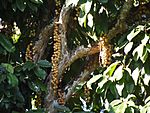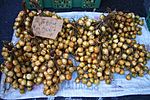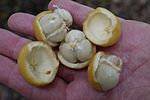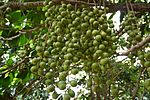Baccaurea motleyana facts for kids
Quick facts for kids Baccaurea motleyana |
|
|---|---|
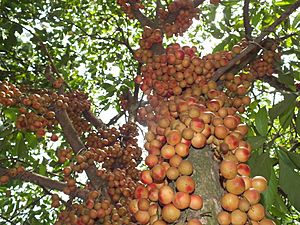 |
|
| Scientific classification | |
| Genus: |
Baccaurea
|
| Species: |
motleyana
|
| Synonyms | |
|
|
Baccaurea motleyana is a type of fruit tree that grows naturally in parts of Southeast Asia. People also grow it for its tasty fruit in countries like Bangladesh, Indonesia, Thailand, and Peninsular Malaysia.
It has many common names. Some of these include rambai and rambi. In Thai language, it's called mafai-farang. In Bengali language, the fruit is known as bugi, lotka, or lotkon (লটকা/লটকন/বুগি). In the Assamese language, it's called leteku (লেটেকু).
About the Rambai Tree
The rambai tree usually grows to be about 9 to 12 meters (around 30 to 40 feet) tall. It has a short trunk and a wide, spreading top, like a big umbrella. Its leaves stay green all year round. The top side of the leaves is shiny green, while the underside is greenish-brown and a bit hairy. Each leaf can be up to 33 centimeters (about 13 inches) long and 15 centimeters (about 6 inches) wide.
This tree is special because it has separate male and female plants. This means that male flowers grow on one tree, and female flowers grow on a different tree. Both types of flowers smell nice and have yellow parts called sepals. The male flower clusters can be up to 15 centimeters long. The female flower clusters can grow much longer, sometimes reaching 75 centimeters (about 30 inches).
The Rambai Fruit
The fruits of the rambai tree grow in long strands. Each fruit is about 2 to 5 centimeters (1 to 2 inches) long and about 2 centimeters (less than an inch) wide. The skin of the fruit is soft and velvety. It can be pinkish, yellow, or brown. As the fruit gets ripe, its skin becomes a bit wrinkly.
Inside the fruit, there's a whitish, soft pulp. This pulp holds 3 to 5 seeds. The taste of the pulp can be sweet or a little bit sour. People enjoy eating the fruits fresh, right off the tree. They can also be cooked, or made into delicious jam or even wine. Besides its fruit, the rambai tree is also useful for providing shade. Its wood can be used, though it's not considered high-quality.
Name Origin
The specific name motleyana was given to this tree to honor James Motley. He was a person who collected plants in southeast Borneo before he passed away.
Gallery


